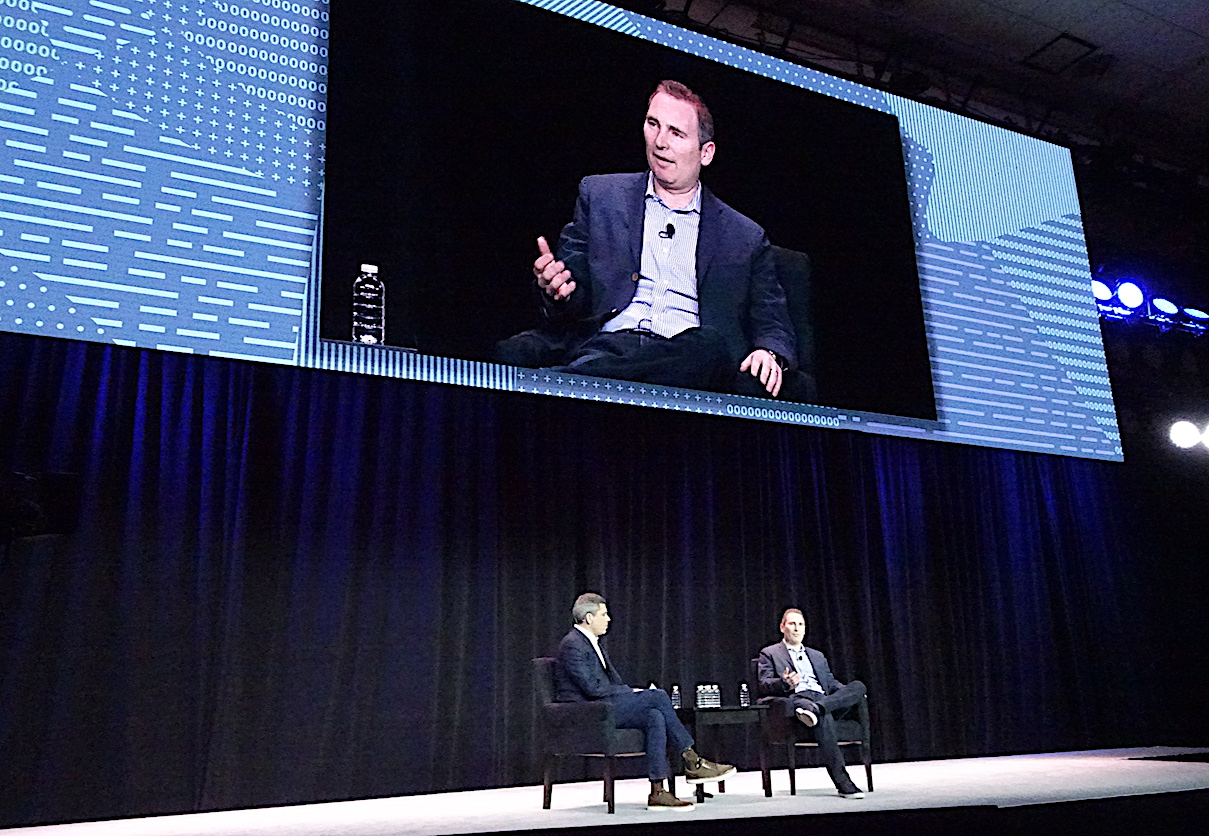 CLOUD
CLOUD
 CLOUD
CLOUD
 CLOUD
CLOUD
Firing new shots at cloud computing rivals such as Oracle Corp. and Microsoft Corp., Amazon Web Services today checked off more boxes to make it easier for large enterprises to develop cutting-edge applications and move them to its cloud.
Amazon.com Inc.’s cloud computing operation unveiled a raft of new services, including faster access to data in databases and ways to create applications using machine learning, at its two-day AWS Summit conference Wednesday in San Francisco. They’re fairly geeky, befitting the audience of software developers, but they’re intended to help it stay ahead of fast-charging rivals such as Microsoft Azure and Google Inc.’s Cloud Platform.
More generally, though, Amazon sought to emphasize both its current dominance and its vision of cloud computing for the next few years. In particular, AWS acknowledged that many companies still want to run at least some operations inside their own data centers. Jassy said AWS would look for new ways to accommodate them, such as the deal it announced last fall to allow VMware Inc. virtual machines, which are ubiquitous in corporate data centers, to run on its cloud.
“We will see most enterprises operate in some kind of hybrid mode for some number of years,” AWS Chief Executive Officer Andy Jassy (pictured) said in a fireside chat at the conference. “It’s not a binary decision. We will allow customers to run in the mode they want to run.”
At the same time, Amazon continued its competitive attack on rivals, especially Oracle, which in turn has made AWS a prime target for its own cloud push. Specifically, Jassy contended in response to a question from moderator Ariel Kelman, AWS’s vice president of worldwide marketing, that AWS’s services have much less ability to lock in customers, a concern that has risen along with AWS’s momentum.
“It’s a question we get a lot, and Oracle has sure made people think a lot about that issue,” Jassy said. “The reality is, when you look at the cloud, it really is nothing like being locked into Oracle. It is much easier to move away from something like the cloud.”
Jassy took issue with another purported trend among companies to use multiple clouds as a hedge against both lock-in and potential performance issues, following an AWS outage for a few hours last fall.
“Most CIOs start off thinking they might split their workloads across multiple cloud providers. Most don’t do that,” Jassy said. He made the case that multi-cloud environments force users to choose the “lowest common denominator” in cloud technologies to ensure compatibility. Moreover, he said, “you effectively diminish your buying power” because cloud providers offer volume discounts.
Not least, he argued that splitting developers’ attention among multiple platforms makes cloud management “a pain in the butt.” That much was echoed by an AWS customer, Slack Inc., whose head of infrastructure engineering, Julia Grace, told SiliconANGLE that “we know how to run Slack at scale on AWS” and currently use other cloud services chiefly for backup.
Amazon Chief Technology Officer Werner Vogels
The products, introduced by Amazon Chief Technology Officer Werner Vogels, ran a wide gamut. For one, Amazon announced a number of AI-related products or general availability. It rolled out to all developers a technology called Lex that it introduced in a preview last fall. Lex allows developers to use the technology underlying its Alexa voice assistant to build voice chat features into their products, with the aim of one day allowing people to control almost any software with their voice. It also upgraded Polly, a computer voice-generating service, so it can whisper as needed, as well as provide “speech marks” for syncing up audio with the movements of online avatars.
AWS also announced Redshift Spectrum, an extension of its data warehousing service that allows users to query data inside AWS’s S3 storage service rather than having to take the time and expense of moving it into Redshift itself first. Citing what might be an extreme example, Vogels said a complex query that would run on an exabyte of data, or a billion gigabytes, with the Apache Hive open-source data query software would take five years and 1,000 nodes or machines. Spectrum would allow that to be done in 155 seconds for a few hundred dollars, he said.
The service represents yet another blow to enterprise data warehouses and big data analytics providers, analysts at Cowen & Co. said in a note to clients. “The ability to keep data in S3 and make it the source of analytical query processes, in our view, challenges conventional Apache Hadoop based approaches for Big Data infrastructure,” they wrote.
Then there were new services mainly intended to reduce friction in cloud use. AWS CodeStar, launched today, is intended to help developers work together more easily to develop and manage software using templates. Also, a new contract arrangement called SaaS Contracts allows customers to pay for subscription software through the AWS Marketplace for one, two or three years at a time and pay for it on their monthly AWS bill. Splunk Inc. CEO Doug Merritt said the program helps make it easier for companies to use its data analysis software.
AWS announced a couple of high-profile new customers as well. Dunkin’ Brands Group Inc., parent of Dunkin’ Donuts and Baskin-Robbins, will move its mobile applications, e-commerce websites and key corporate infrastructure applications from on-premises infrastructure to AWS. Map and location services firm Here Technologies, a customer for several years, said it would make AWS its preferred cloud provider.
Vogels said it all adds up to a new era in software and computing: “Cloud has become the new normal, the default environment to build new applications.”
THANK YOU